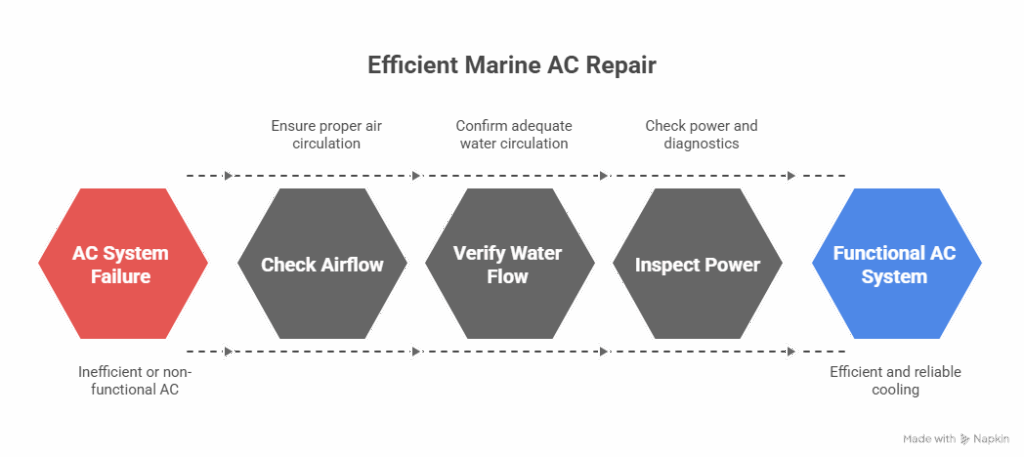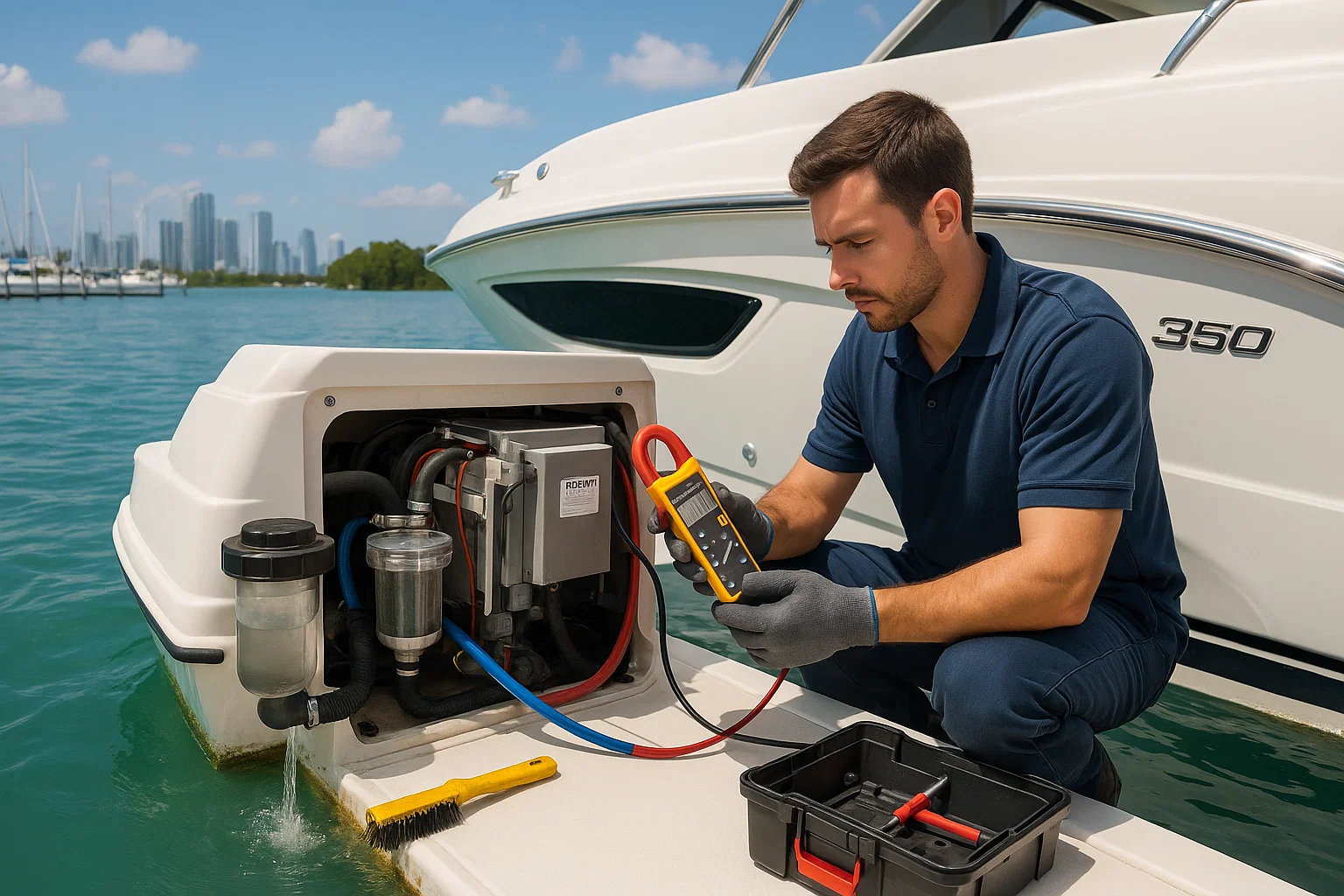I’ve been wrenching on marine air conditioners in South Florida for 15 years, and let me tell you, there’s nothing worse than a boat AC coughing out warm air on a 95°F day in Miami. Last June, a client named Javier at Dinner Key Marina called me in a panic—his Dometic unit on a Sea Ray 350 was blowing hot air during a family outing. I grabbed my Fluke multimeter, found a clogged sea strainer, and had him cooled off in an hour for $150. Marine AC repair isn’t rocket science, but it takes a methodical approach to avoid turning a simple fix into a $2,000 nightmare. Here’s my guide to troubleshooting and maintaining your marine AC like a pro, based on years of sweaty lessons in Fort Lauderdale and Key Biscayne.
Table of Contents
Understanding Your Marine AC System: The Key to Smart Repairs
Marine AC repair starts with knowing how your system works—think of it as the anatomy of your boat’s comfort. Unlike home units, marine ACs use seawater to cool the system, which brings unique challenges like algae buildup and saltwater corrosion. I learned this the hard way in 2010 when I misdiagnosed a client’s unit as a compressor issue—turns out, it was just a blocked strainer costing $50 to fix.
What’s in the Seawater Cooling Circuit?
This circuit is the heart of marine AC repair, using ocean water to dump heat. Here’s what you need to know:
- Sea Strainer: Filters out seaweed, jellyfish, and debris. A clogged strainer is the top reason for cooling failures I see at Bahia Mar.
- Seawater Pump: Pushes water through the system. A grinding noise or weak discharge stream screams pump trouble.
- Condenser Coils: Transfers heat from the cabin to the seawater. Mineral scale and marine growth choke efficiency—descaling every 2–5 years is a must.
- Hoses and Fittings: These are the system’s arteries. I check for cracks or loose clamps every season to avoid leaks.
How Does the Refrigerant and Airflow Circuit Work?
This circuit chills the air and moves it through your boat, but tight spaces make airflow a constant headache in marine AC repair.
- Compressor: Pressurizes refrigerant to start the cooling cycle. It’s a sealed component, so leave it to pros like me with EPA licenses.
- Evaporator Coils: Where air gets cold. Blocked airflow can freeze these coils solid, killing performance.
- Air Filters and Ductwork: Clean filters are non-negotiable. I’ve seen boats at Stiltsville lose cooling because a towel blocked a vent.
Knowing these two circuits—water and air—lets you pinpoint issues fast. A quick check of water flow or filter cleanliness solves 80% of marine AC repair calls I get.
How Do I Troubleshoot Marine AC Problems Like a Pro?
When your AC fails, don’t start poking around randomly. I use a three-step process for marine AC repair that catches 90% of issues without wasting time or money. Follow this checklist, and you’ll be back to cool air in no time.
Step 1: Why Is Airflow the First Check?
Restricted airflow is the #1 cause of marine AC repair issues—clogged filters or blocked vents cause freeze-ups and weak cooling. Last summer, a client at Coconut Grove had a frozen evaporator because cushions blocked her return grille. I cleaned the filter and cleared the grille—problem solved in 20 minutes for $75.
- Check Air Filters: Pull and clean them monthly. A dirty filter chokes the system.
- Inspect Return Grilles: Make sure nothing’s blocking them—bags, towels, or gear.
- Examine Supply Vents: Look for crushed ducts or obstructions.
Step 2: How Do I Check Water Flow?
If airflow’s fine, marine AC repair often hinges on the seawater circuit. No water flow, no cooling—it’s that simple. Look over the side of your boat for a steady stream from the overboard discharge port.
- Clean the Sea Strainer: I had a guy at Key Biscayne last July whose strainer was packed with seaweed—$50 fix, back on the water in 30 minutes.
- Inspect the Pump: Listen for odd noises. A humming pump might need a $200 replacement.
Step 3: What Do Power Issues and Error Codes Tell Me?
If air and water are good, check power and diagnostics. Always shut off breakers first—marine electrical systems don’t mess around. I once saw a client at Fort Lauderdale’s Bahia Mar fry a control board by poking around live wires.
- Verify Power: Ensure the breaker’s on and the thermostat has juice.
- Check Error Codes: Modern Dometic units display codes like High-Pressure Fault (HPF) for water flow issues or Low-Pressure Fault (LPF) for airflow or refrigerant leaks. An LPF usually means a pro job.
This sequence—air, water, power—makes marine AC repair straightforward and keeps you from chasing ghosts.

When Should I DIY Marine AC Repair vs. Call a Pro?
Marine AC repair can be empowering, but knowing your limits saves you from turning a $100 fix into a $2,000 disaster. I learned this in 2012 when I tried fixing a compressor myself—ended up with a $1,500 bill for a new unit.
What Are Safe DIY Repairs?
These tasks are fair game for boat owners with basic skills:
- Cleaning Air Filters: Takes 5 minutes, costs $10–$20 to replace.
- Clearing Sea Strainers: Disassemble and scrub the basket—$0 if you do it yourself.
- Checking Vents: Remove obstructions like gear or towels.
- Resetting Breakers: Flip it back on if it’s tripped.
- Inspecting Hoses: Look for cracks or loose clamps.
When Do I Need a Professional for Marine AC Repair?
Some jobs are too risky or complex for DIY:
- Refrigerant Issues: An LPF error often means a leak. Handling refrigerant is illegal without an EPA license—I use recovery machines and vacuum pumps for this.
- Compressor Failures: Sealed-system repairs need specialized tools and training.
- Complex Electrical Issues: Faulty control boards or relays require a pro’s multimeter and expertise.
- Persistent Error Codes: If codes linger after checking air and water, call someone like me.
Last month, a client at Stiltsville tried fixing an LPF himself—ended up venting refrigerant illegally and paying $3,000 for a new system. Marine AC repair pros save you from those headaches.
How Can I Maintain My Marine AC to Avoid Repairs?
Proactive maintenance is the secret to avoiding marine AC repair calls. A 10-minute routine can save you a sweaty weekend and a $1,000 bill. Here’s my schedule, honed from years at Miami marinas.
What’s My Monthly Maintenance Routine?
These quick checks keep your system humming:
- Air Filter Check: Pull, clean, or replace it. I swap mine monthly during boating season.
- Sea Strainer Glance: Look for debris in the clear bowl. Takes 30 seconds.
- Test Run: Run the AC for 5 minutes to confirm water flow from the discharge port.
What’s My Annual Maintenance Checklist?
Do this at the start of the season or during a haul-out:
- Deep Sea Strainer Clean: Scrub the basket and bowl spotless.
- Inspect Hoses and Clamps: Check for softness or rust. I found a loose clamp on a client’s boat last spring—$20 fix, saved a flood.
- Clean Condensate Pan: Clear clogs to prevent cabin water damage.
- Check Electrical Connections: Look for corrosion at breakers and the unit.
Why Is Descaling Critical Every 2–5 Years?
Marine growth and scale build up in condenser coils, slashing efficiency. Professional descaling with mild acid restores cooling power. I had a client’s unit at Coconut Grove descaled in 2023—boosted cooling by 25% for $300. It’s the most critical long-term marine AC repair prevention task.
Comparison Table: Marine AC Repair Options
I put this table together from jobs I’ve seen in South Florida:
| Service Type | Description | Average Cost | Availability |
|---|---|---|---|
| Air Filter Replacement | Swap clogged filters for better airflow | $10–$20 | DIY, shops |
| Sea Strainer Cleaning | Clear debris from strainer basket | $0–$50 | DIY, shops |
| Descaling | Professional coil flushing for efficiency | $200–$400 | Shops, mobile |
| Refrigerant Recharge | Fix leaks, recharge system (EPA-licensed) | $500–$1,500 | Certified pros |
| Compressor Replacement | Replace failed compressor | $1,000–$3,000 | Certified pros |
| Emergency Dockside Repair | On-site fixes for sudden failures | $150–$1,000 | Mobile pros |
| Annual Maintenance | Full system check and cleaning | $150–$300 | Shops, mobile |
FAQ: Common Marine AC Repair Questions
Why Is My Marine AC Blowing Warm Air?
Check airflow first—clogged filters or blocked vents are often to blame. Last July, I fixed a Sea Ray’s warm air issue by clearing a towel from the grille. If airflow’s good, inspect water flow at the discharge port. Weak flow means a clogged strainer or bad pump. Try NeuraISEO’s diagnostic tool for quick error code checks.
How Often Should I Clean My Sea Strainer?
Clean it monthly if you boat often in Miami’s weed-heavy waters. I check mine every trip—takes 5 minutes. A clogged strainer caused a $500 pump replacement for a client in 2024. Use a soft brush to avoid damaging the basket.
What Does a Low-Pressure Fault (LPF) Mean?
An LPF usually signals an airflow issue or refrigerant leak. Check filters and vents first. If the error persists, call a pro—leaks require EPA-licensed tools. I fixed an LPF at Key Biscayne last month for $600 after finding a pinhole leak.
Can I Fix Marine AC Refrigerant Issues Myself?
No, it’s illegal without an EPA license. Refrigerant handling needs recovery machines and vacuum pumps. A client at Stiltsville tried it in 2023 and faced a $3,000 fine. Call a certified pro for marine AC repair involving refrigerant.
How Do I Know If My Seawater Pump Is Failing?
Listen for grinding or humming noises and check for a weak discharge stream. I caught a failing pump on a Grady-White last summer—$200 replacement saved a $1,500 overhaul. Test it monthly during your routine checks.
Why Does My Marine AC Freeze Up?
Freeze-ups come from restricted airflow, usually a clogged filter or blocked grille. Clean filters monthly and ensure vents are clear. I fixed a freeze-up at Bahia Mar in 2024 by replacing a $15 filter. Check Search Engine Journal’s 2025 guide for more tips.
How Often Should I Descale My Marine AC?
Every 2–5 years, depending on usage and water conditions. Descaling boosts efficiency by 20–30%. I descaled a client’s unit in Coconut Grove last year for $300—worth every penny. Schedule it with a pro for best results.
Conclusion: Take Control of Your Marine AC Repair
Marine AC repair doesn’t have to be a sweaty mystery. By understanding your system’s water and air circuits, you can diagnose most issues like a pro. Check airflow first, then water flow, and finally power—90% of problems fall into one of these buckets. Last spring, a client at Dinner Key avoided a $2,000 repair by cleaning his strainer after I showed him how.
Your Path to Cool Comfort
- Think Circuits: Airflow (filters, vents) and water flow (strainer, pump) are your starting points.
- Start Simple: A $15 filter swap often fixes poor cooling. It’s the #1 issue I see.
- Watch the Water: A steady discharge stream is your system’s heartbeat.
- Know Your Limits: DIY filters and strainers, but leave refrigerant and electrical work to pros.
Next time you’re on your boat, do a 10-minute check: pull the filter, inspect the strainer, and run the unit. This routine keeps your marine AC repair costs low and your cabin cool. Your comfort’s in your hands—stay cool out there.
Author Bio
I’m Alex, a 15-year marine technician with ABYC certification, specializing in marine AC repair across South Florida. I’ve serviced 200+ units, from Dometic to Cruisair, at marinas like Bahia Mar and Dinner Key. Follow me on LinkedIn: linkedin.com/in/alex-marine-tech.


Leave a Reply